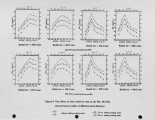| Title |
The Experimental Study on Emission of Nitrogen Oxides in a 70,000 Btu/Hr Gas Fired Furnace |
| Creator |
Ma, H. K.; Hsieh, D. M. |
| Publisher |
University of Utah |
| Date |
1992 |
| Spatial Coverage |
presented at Cambridge, Massachusetts |
| Abstract |
The experimental study is to investigate the control of thermal nitrogen oxides emissions from a 70,000 Btu/hr gas-fired test furnace. Tests, included changing axial or radial air flow rate, adding cooling water, and adding staged air were performed to characterize and optimize the fuel-rich burning zone and the fuel-lean burnout zone independently. Detailed measurements of O2, CO2, CO, NO and NOx were made at the fuel-rich burning zone and furnace exit. The influence of forming CO, NO and NOx was examined. Results indicated that adding staged air in the fuel-rich burning zone (75cm from burner) will reduce the maximum NO and NOx emissions. Adding cooling water in a right position may further lower the NO and NOx emissions. In addition, the least formation of thermal nitrogen oxides in the first stage fuel-rich burning zone will occur at the stoichiometric ratio's inverse value, (o1)^-1, 0.65 to 0.7. |
| Type |
Text |
| Format |
application/pdf |
| Language |
eng |
| Rights |
This material may be protected by copyright. Permission required for use in any form. For further information please contact the American Flame Research Committee. |
| Conversion Specifications |
Original scanned with Canon EOS-1Ds Mark II, 16.7 megapixel digital camera and saved as 400 ppi uncompressed TIFF, 16 bit depth. |
| Scanning Technician |
Cliodhna Davis |
| ARK |
ark:/87278/s6st7sfx |
| Setname |
uu_afrc |
| ID |
12600 |
| Reference URL |
https://collections.lib.utah.edu/ark:/87278/s6st7sfx |

















